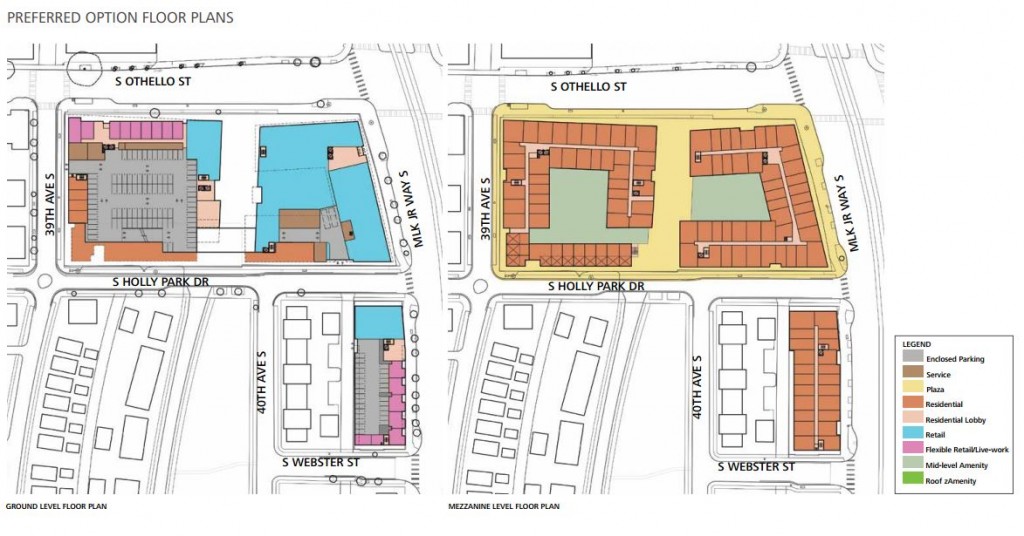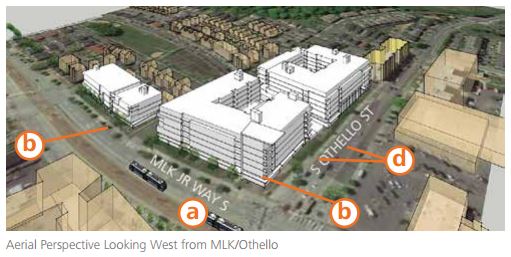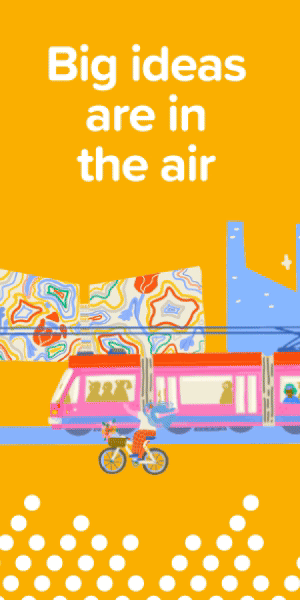
When Link opened in 2009, it was expected to be a catalyst for transit-oriented development (TOD) in the Rainier Valley: MLK Way is littered with the sort of auto-oriented, suburban-style development that defines placelessness, and is ripe for redevelopment. A unprecedented economic downturn delayed those aspirations somewhat, and for a long time The Station at Othello Park was the only example of TOD in the Valley–but things are looking up.
The Problem
 The Seattle Housing Authority has found a developer for its 3.2 acre site at the corner of MLK Way and Othello Street, right next to Sound Transit’s Othello Link Station. The plans are impressive: 505 market-rate apartments spread over three buildings, 17,800 sq. ft. of retail space, and a 10,000 sq. ft. of public plaza intended to provide space for a farmer’s market and community events. But the developer, Everett’s Path America, has fallen into the same trap many have when planning TOD by forgetting the “Transit” and focusing on the parking. Instead, Path America is proposing a whopping 523 surface and underground parking stalls for those 505 apartments.
The Seattle Housing Authority has found a developer for its 3.2 acre site at the corner of MLK Way and Othello Street, right next to Sound Transit’s Othello Link Station. The plans are impressive: 505 market-rate apartments spread over three buildings, 17,800 sq. ft. of retail space, and a 10,000 sq. ft. of public plaza intended to provide space for a farmer’s market and community events. But the developer, Everett’s Path America, has fallen into the same trap many have when planning TOD by forgetting the “Transit” and focusing on the parking. Instead, Path America is proposing a whopping 523 surface and underground parking stalls for those 505 apartments.
It’s a serious and well known problem: A recent report from the Sightline Institute found that 21 of the 23 recent multifamily developments studied had more occupied units than occupied parking stalls, with an average overnight parking vacancy rate of 37%. Those empty stalls do more than waste space; they cost developers a lot of money, costs that ultimately get passed on to tenants:
…We estimate that the developments in our sample incurred losses on parking ranging from 6 percent to 42 percent of monthly apartment rents, or an average of money on parking. $246 per apartment per month. Assuming that landlords generally recover losses on parking through the rents they charge their tenants, an average of 15 percent of tenants’ rental payments in our sample cover the building’s losses on parking. In short, the tenants of the buildings in our sample—even those who didn’t park on-site—paid for on-site parking through their rent.
It’s exciting to see development in the Rainier Valley take off. Seattle needs more affordable housing, and converting low-density (or vacant) land uses to medium- and high-density housing is a great way to meet that need. Likewise, taking advantage of major regional investments in transit is critical for ensuring affordability by freeing tenants from the burdensome cost of owning and maintaining car. Considering such realities, it boggles the mind that a major developer is planning to put more parking stalls than actual apartment units next to three frequent transit lines (Central Link Light Rail and King County Metro Transit Routes 8 and 36) in one of the poorest parts of Seattle. Not only is it a wasted opportunity, but it denies affordable housing in an area that desperately needs it.
Take Action
The Southeast Design Review Board will be taking its first look at the proposed development (project notices #3017470 and #3017475) this Tuesday, August 26, from 6:30-8:00 pm at the Rainier Valley Cultural Center, giving advocates a chance to urge the developer to use a saner amount of parking.
Please make it to the meeting if you can. Public testimony is certainly the most effective way to commute your thoughts to the Design Review Board. Alternatively, you can contact the Department of Planning and Development directly at PRC@seattle.gov or the project planner, Bruce Rips, with your comments. If you choose to send an email, note the urgency of your comments and be assertive that they must be read out or referred to the Board on Tuesday by the project planner.
Will became inexplicably interested in city planning, design, and urbanism after growing up in mostly-suburban Ohio. After spending 5 years living in Seattle's Rainier Valley, he relocated to San Francisco's Tenderloin neighborhood along with his wife and cat.






